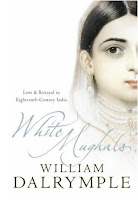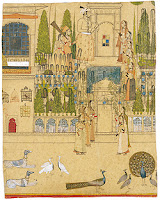Incredible 18th Century India
I recently completed reading White Mughals by William Dalrymple. At its core is the improbable love story and marriage between James Kirkpatrick, the East India Company's Hyderabad resident at the end of the 18th century, and Khair Un-Nissa, the grand-daughter of a high ranking official at the court of the Nizam of Hyderabad. In spite of it’s imposing size, the book is a gripping documentation of the times and of history at its most appealing. The book provides new insight into a rarely discussed period of Indian history.
In spite of it’s imposing size, the book is a gripping documentation of the times and of history at its most appealing. The book provides new insight into a rarely discussed period of Indian history.
And what a fascinating period in Indian history that was! This was a time when traders, soldiers, and artists from the western world came to visit, but stayed on. They stayed because the Indian princes paid them better, they stayed for the open culture that wasn’t prudish and embraced outsiders, but they also stayed because of the women! Many European officers during this time took up Indian wives and/or concubines. In fact, a third of all wills made by British officers during this period leave property and/or money to Indian women they left behind. Some Europeans during this time even became practicing Hindus and Muslims, in most cases influenced by the women in their lives.
So many British officers and soldiers were ‘going native’ during this time, that England fresh from defeat at the hands of Americans (another population of British-gone-native!) decided drastic measures were called for. And so began a new regime of segregation that discouraged inter-marrying, barring children born of mixed marriages from jobs in the British Army, and discouraging officers from even wearing Indian clothes or using the hookah. The 18th century was also when the only source of diamonds in the known world were mined in Golconda. An era when soldiers frequently defected from the Portuguese, French and British armies to join those of the Indian princes. Both Tipu Sultan and the Maratha armies (two of the best during these times that won many a battle with the British and/or the powerful Mughal emperors of the north) were commandeered by Europeans.
The 18th century was also when the only source of diamonds in the known world were mined in Golconda. An era when soldiers frequently defected from the Portuguese, French and British armies to join those of the Indian princes. Both Tipu Sultan and the Maratha armies (two of the best during these times that won many a battle with the British and/or the powerful Mughal emperors of the north) were commandeered by Europeans.
I was completely immersed in this fascinating book during my recent trans-Atlantic flight to the United States. Dalrymple’s other best selling books are the City of Djinns on Delhi and his latest, The Last Mughal, which covers the period of Bahadur Shah Zafar and the Indian Mutiny.


14 comments:
I enjoyed the review
I am on the verge of finishing this brilliant book and was intending to do a review myself. Interesting to read yours too. How long did it take you to finish it?
@vishal: Read it over multiple sittings. Probably took me over two weeks to finish, but most of it during the 14 hour flight from Mumbai to Houston.
William Dalrymple seems to combine erudition with a very easy read - pretty addictive stuff. I havent found anything better on Delhi than the City of Djinns. Another Dalrymple I found really interesting was From the Holy Mountain, which is about the Eastern origins of Christianity. I come from Kerala where there are a large number of Syrian christians. This book finally allowed me to understand their roots a lot better. Strongly recommended.
White Mughals sounds like a grat book that reveals many insights into 1800 in India.
Shantanu, WOW! A good review, and as a history afficiando, I am marking this book in my "To Read" list.
Reading through your review, I also wanted to share that as we don't learn from history, history often repeats.
As a foodie, I also was pretty intrigued by how "Mulaga rasam" [spicy chicken rasam/shorba] morphed into Mulligatawny soup via the British military:)I know its unrelated to your write up, but reading about the British military brought this memory to the foreground.
@hari nair: I agree. While I have seen people criticize the fact that he uses footnotes, I think his books are still very easy to read and they keep you intrigued till the end.
@sam: Yes, especially since the intermingling in this period is missing from our history books which tend to cover the earlier years and the later British India in more detail.
@lakshmi: Very interesting!
I happened to attend the book launch of White Mughals at Bombay House last year. He laid out the premise of his book beautifully, using slides and large dollops of humour. Clad in white Kurta Pyjama, Dalrymple brought the auditorium alive.
Managed to get his Age of Kali autographed :)
@anil: Cool! I really like his writing style and depth of research. I expect to begin reading some of his other books now.
Like your blog, came across it while looking for fellow "White Mughals" readers. I too recently read and reviewed "White Mughals" on my blog. Was glad I enjoyed it as much as "City of Djinns". Now am onto his next "Last Mughals". Yeah! Looking forward to a couple of weeks of good reading :)
@chica: Would love to know how you find the Last Mughal.
This was a nice teaser. .. would now want to read this book. Your write up was very intriguing.
@Lizy: Thanks for visiting. Liked the two posts on your blog...you should write more!
It is a book (white Mughal) which is patchy, large chunks of time are missing. Interesting facts, but needed good editing. Any day
Post a Comment